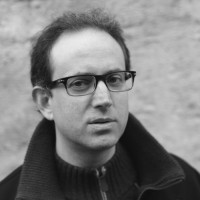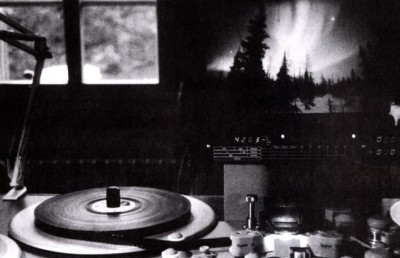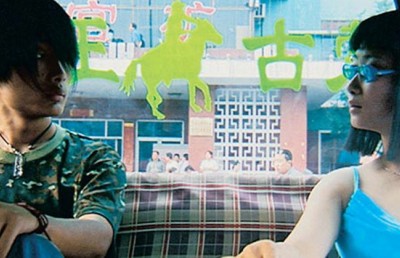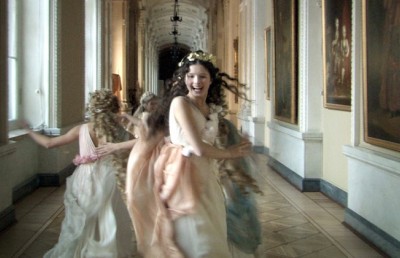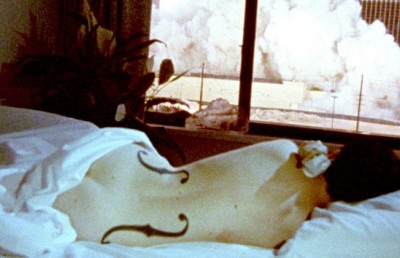FCMM 2002 Dossier : Short Films Exposed
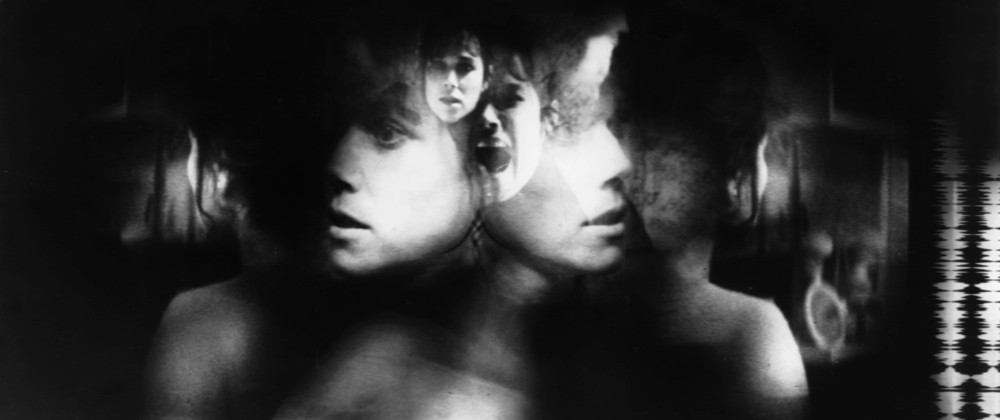
This year the FCMM did away with their live new media performance series, a lack that I sorely felt. I’ve been trying to figure out why they are abandoning the very component of the festival that kept them on the cutting edge. I’ve heard murmurs about too much crossover with Mutek; indeed, many of the artists that have been featured at FCMM have also been prominent in Mutek. However, FCMM concentrated on acts that were audiovisual in nature, while Mutek is first and foremost a music festival. The world of live audiovisual performance is growing rapidly, and to me FCMM was the prime showcase for leading talent in this area. Mutek is world renown for the quality of its electronic music programming, but the visual component is just not their priority. But things change. Mutek 2002 did introduce its Mutek_Vision film series (see report in this journal), and once in a while an act would incorporate a visual element beyond the now standard projection of their software interface. Conversely, FCMM’s live offerings in the past did have some strictly audio works. So perhaps there is, in fact, a blurring of the boundaries between these two festivals and their mandates. I don’t, however, see this blurring as a problem, nor a reason to completely shut down FCMM’s live component. I’m still drooling over Wetfish’s live accompaniment to Lang’s Metropolis at last year’s FCMM, a decidedly non-Mutek event, and I’m dreading the thought of no longer having a venue for like-minded affairs. Also, I question FCMM’s ability to meet its mandate as “New Media” festival if it restricts itself to the confines of “Film Festival.” Yes, they have a lot of digital works represented, but in an age where big budget Hollywood films are now being shot on digital I think the novelty has worn off.
The Michael Snow retrospective, of course, was a monumental event, but was not one that falls outside the scope of the special event and retrospective programming that the Cinémathèque Québequoise is dedicated too. In fact, the Snow event was hosted by them, and seemed to tie in with FCMM as a matter of convenience. Only the offering of one live musical performance and the launch of the Digital Snow DVD-Rom brought the Snow event into the realm of the FCMM. And here I will say that it is something of a travesty that Snow’s performance with CCMC was scheduled against the one and only screening of La Région Centrale. If the need to schedule the concert against one of Snow’s films was inevitable, then I suppose it makes sense to have picked one of the filmmaker’s longer and more difficult pieces. However, I really think they should have avoided any conflict whatsoever, since I could not pass up the opportunity to see a print of Région, and so was forced to miss CCMC.
The Digital Snow DVD is very much a piece of new media, and I applaud the efforts of its producers and the inclusion of its official release within the context of FCMM. The DVD-Rom format has the potential to be a truly revolutionary medium and I am very interested in seeing more people exploit this potential. Designed as an encyclopedia of Snow’s work, the DVD also acts as an interactive environment which stimulates exploration of the connections between his different projects. Its main interface is based on a sequence from his film Rameau’s Nephew. This not only illustrates the connections that can be drawn between the film and the functioning of the DVD, but stimulates an understanding of Snow’s own working processes. Snow is a true multi-media artist, and the fact that he is involved in so many different kinds of works suggests some fundamental connection that underlies it all. Drawing the line between his varied projects is the main function of the DVD. How does his improvised music relate to his structural film? How does the Walking Woman figure into a variety of different contexts? And what the hell is up with Corpus Callosum? The user can find answers to these kinds of questions by navigating the hyperlinks that join relevant works together along with texts written about them. As such, Digital Snow is very much about breaking down the boundaries between different media and exploring the hypertextual environment of human creativity.
The FCMM itself should be more geared towards this kind of exploration if it is to keep the “New Media” section of its name, rather than trying to avoid overlap and specializing on the medium of film (digital or otherwise) alone. However, new media always has its problems, emphasized by the fact that the first version of Digital Snow (1.0) is apparently bugged. This came to light after I paid $90 for it only to discover that it would not install properly on my system. A couple weeks after sending an email to support, they replied by telling me that I could exchange it for version 1.1 (but without telling me how this might be accomplished), and then stating that I would soon hear from a technical advisor to see if there might be a way of circumventing the problem. I’m still waiting.
With the live events gone and the feature films focusing more and more on internationally celebrated work that is likely to be released after the festival, FCMM’s last bastion of the cutting edge is their short experimental film programmes. Though the Mutek_Vision short film series was interesting, FCMM still has a lock on this domain in Montreal. These are the programmes in which we can be exposed to works that would have no other home. And for me, this is what festival going should be about.
On the topic of material that would have no other home, two of the short programmes delivered packages of works I had been expecting for some time without knowing where and when such a thing would ever come to be. When I was considering, along with everyone else, what effects the events of September 11th would have on the world, I immediately wondered if and when we would start to see echoes in the works of media artists. Touchy subject that it is, I didn’t figure that much in the way of mainstream American work would deal with it other than to wipe the World Trade Center out of Spider-Man, remove terrorist themes from Collateral Damage, and throw a bunch of pro-American hero worship on the production slate for the upcoming years. And let’s not forget comedy – lots of comedy. After all, it is time to laugh again. But be careful now – don’t laugh at the wrong things.
This is why The Simpsons has felt the pinch. Not so ironically, Homer and the gang have been dealing quite scathingly with many of the pieces of the puzzle that came together on September 11th, pieces that won’t be shown again any time soon. While some of the more roundabout dealings will still sneak through, like when Springfield votes on “Proposition 24” to deport all illegal immigrants from the town, others will not. Like the time Bart becomes a member of a boy-band being secretly manipulated by a crazed Navy Lieutenant bent on recruiting as many as possible to defend his beloved homeland. When word gets out that Mad Magazine is about to run a spoof of the band, thereby ruining the credibility of his media construction, his plans of warping the minds of impressionable video viewers with subliminal messages is thrown down the tubes. To prevent the interference, he hijacks a battleship, sets sail to New York, and blows up the Mad Magazine building. The World Trade Center is seen not too far away. I’ll be surprised if we will ever again be able to watch a representation of a building in downtown New York explode into bits and then laugh as people emerge from the rubble, asking: “everyone okay?” to which one responds: “I actually feel better!”
We used to enjoy witnessing disaster. As another episode illustrates, Homer and Bart sit glued to the television watching “When Buildings Collapse” on Fox. Cheering and hollering as each shot of destruction passes across the screen, the father and son team epitomize our fascination with death and destruction captured on tape. Lisa enters at one point and reminds them that “maybe someone got hurt” to which Homer, not having considered the idea, says “Hey yeah!” and starts chuckling to himself. But the post 9/11 world will not so readily allow such blatant satiric critique of our media consumption habits, particularly in North America. And so The Simpsons is now relegated to dealing with the issue by having a second grade spelling bee contestant spell the word “Anthrax” in the contest finals.
The pre 9/11 Simpsons episodes illustrate some fundamental questions I ask of myself when considering my own fascination with images of disaster and terror. First of all, there is the question of understanding the place of the individual within a large scale event. There is a difference between watching an individual die in close-up and watching a building collapse from a distance. Even though I know that there are thousands of people in the building, I don’t see it the same as if I was to watch each individual die up close. This, of course, is something that most of us understand implicitly. This fact was also made clear in the way that September 11th was covered in the news. We can watch shots of the planes hitting the towers and the towers collapsing over and over, but the shots of the individuals jumping from the windows of the towers were scarce indeed. Though in the days following the tragedy the news featured as many personal stories surrounding the event as possible, raw footage of individuals dying was kept to a minimum. Subsequent official releases of September 11th footage also complied with this strategy. On the DVD that accompanies the CBS book What We Saw, only one shot of someone jumping from the towers is included. And in the 9/11 documentary, they clearly state that a certain crashing sound heard repeatedly from inside the lobby of the first tower is that of people falling from the floors above. However, as is the case with the filmmaker’s decision not to capture footage of someone on fire when they first enter the building, they do not show any shots of the jumpers. Only the reactions on the faces of the firefighters tell the tale.
Another issue that is raised by 9/11 is the fact that it was created for the media coverage that its perpetrators knew it would receive. The whole of the connected world has seen the footage – because we want to see the footage. If there was no demand, there would be no market for such an event. 9/11 was tailor-made for societies who can’t get enough visual spectacle. It is precisely for this reason that I immediately expected many media artists in the world to latch onto the continuous stream of visual materials coming in from the news coverage of the event and use it as the building blocks for works that deal with this issue. And I am glad to see that there was a place for such works at this year’s FCMM within the framework of the festival’s short programmes.
There were two short programmes dealing with 9/11. Both were collections of shorts culled from around the world. However, one was the work of high profile directors commissioned by French producer Alain Brigand to create “cinematic counterpoint to a shocking television image,” while the other programme was of no-budget independent and much more avant-garde works. Within the first programme, joined together under the unifying rubric of the title 11’09”01, there were indeed a variety of responses to the event. Samira Makhmalbaf illustrated the troubles that Iranian children have in comprehending the event in the absence of media. Her piece culminated in a school teacher using a large chimney in the courtyard as an example of a tower so that the children might have some kind of visual understanding of what the world trade center looked like and the implications of the towers coming down. Claude Lelouch showed us a deaf woman who breaks up with her boyfriend just as he is off to work at the World Trade Center. She has the TV on, but goes to the other room to have some breakfast. We see her in the background while the breaking news of the tragedy unfolds before us on the little screen. Like the Makhmalbaf piece, Lelouch explores 9/11 in the context of media deprivation, though the latter piece through physical instead of geographical impairment. Lelouch’s piece is also interesting when considering that television is geared more towards audio, having been established on the paradigm of radio and given the domestic viewing situation wherein the TV is often on while “viewers” are not “watching.” News shows as well as drama and sitcoms will gear their audio channels toward catching a person’s attention during important or climactic moments so that they may be called back to the screen to witness them with their eyes. It is the visual information that packs the punch, which is why the auditory strategies for alerting the inattentive viewer are used.
Alejandro Gonzalez Iñárritu’s piece demonstrates clearly the punch that visual information packs. His contribution to 11’09”01 consists entirely of the tower jumping footage that was so scarcely seen in the news coverage. To highlight both the scarcity of the image’s availability as well as the extreme emotional effect of the images themselves, he doles them out in brief flashes inserted between long stretches of black screen. The soundscape he created is continuous throughout and is suitably intense, creating a highly charged environment in which to receive the visual blasts. The flashes get increasingly longer as the film progresses, and the shots are organized so that with the increase in length there is also an increase in how far we see the individual jumpers fall. The climactic moments come when he lets a shot of a complete fall run entirely, and then doubles the length of such a shot by linking two together through a dissolve. For me this was the most effective of the films since it highlights the act of media reception that many of us practice in the wake of events like 9/11. We sit glued to the television in the midst of nothingness, waiting for brief glimpses of horror that charge us with the adrenaline of voyeuristic satisfaction. Indeed, Iñárritu seems to have had access to every shot of the tower jumpers available, and has compiled them here for those of us who were not as diligent with the record function on our VCRs.
Peter Mathews, in his review of the film for the January 2003 Sight and Sound, considers Iñárritu’s entry to be the worst of the lot: “The callowness of youth doesn’t excuse (though it probably explains) an unremitting monstrosity to put beside Damien Hirst’s remark that the WTC attack was “like an artwork in its own right.” Iñárritu is 29. So am I. By Mathews’ logic this explains why I liked this entry the best out of the lot. And given my comments about 9/11 being designed for the media, perhaps Mathews would also place me beside Hirst. However, the concept of art is wide-reaching indeed. However callous it may make me seem, I would challenge anyone to suggest that there wasn’t an art to the deployment of the events of September 11th 2001. But I’m going to get myself into philosophically dark waters if I go any further trying to make distinctions between acts of brutal (if well-planned) violence and the paintings of Rembrandt. So I’ll close the debate with this: In a recent lecture at Concordia University, painter David Elliot defined the art of painting as “deciding what to put where.” Indeed, a certain group of terrorists decided they were going to put a couple of planes into the World Trade Center. Anyone who has played pre 9/11 versions of Microsoft’s Flight Simulator knows how tricky this little feat can be; now try it for real. And there you have it.
The antithesis to Iñárritu’s piece came in the other short programme, entitled Traces of Time: September 11th. French videomaker Loic Connanski created Empire II (Le Retour), a 31 minute exploration of the banalization of epic tragedy through its propagation on television. In Empire II Connanski has also compiled a veritable encyclopedia of 9/11 footage, but here presents it in a way that emphasizes its repetition through mainstream media rather than the brief glimpses we often wait for in the context of entire newscasts. Connanski’s piece also highlights the effect of geographical disposition in response to 9/11, and illustrates how difficult it can be to really understand an event like this simply by watching it on television.
He begins the piece with a shot of himself next to a TV showing the burning towers, stating “today the situation on television is worse than usual.” He then walks over to his window which looks out over Paris, and notes that “Paris is still the same as always.” In this way he sets up an opposition between the supposedly world-changing event being played out in the media and the reality of his own situation as a citizen of France. He then proceeds into the kitchen where he makes a pot of coffee to snap him out of the daze of another dreary day where nothing happens. However, each and every step involved in this process is explained by him on the voiceover and shown in grueling detail by his camera. Each little step is repeated several times, and then intercut with some climactic 9/11 footage also repeated several times. So we alternate between six shots of him opening his cupboard and six shots of a plane hitting a tower; six shots of him opening a can of coffee followed by six shots of a tower collapsing; six shots of him scooping out some coffee grinds followed by six shots of someone screaming on the street covered in dust. At first I found the technique to be crude, but as the video carried on it started to gel. This film is gold for anyone truly craving 9/11 imagery while successfully commenting on the results of such craving being satisfied through media saturation. All the key footage is shown over and over and over until it becomes just as mindless as Connanski’s morning cup, or the original Empire itself – Andy Warhol’s 8 hour static shot of the Empire State Building.
Historical context was also a key concept at work in the films on 9/11. Two of the pieces, one in each programme, dealt with the theme of circularity of fortune. On September 11th 1973, Salvador Allende’s socialist government in Chile was toppled in a coup sanctioned by the CIA. Both Ken Loach’s film in 11’09“01 and Claudia Aravena Abugosh’s 11 de Septiembre in the Traces of Time programme present archival footage of the coup’s destructive violence in the streets of Chile, with one shot of a government building on fire particularly poignant in its visual analogy to the burning towers of the World Trade Center. However, much more than visual analogy fostered by numerological coincidence is being put forth here. Loach’s film seems to suggest that, with the events of 2001, the terror that the US has unleashed without challenge in other parts of the world is being brought back to home soil. Abugosh’s film focuses more on the fact that history forgets some tragedy while putting others front and center, and seeks mainly to remind the world that bad shit has gone down in places other than New York.
Remembrance of tragedies past is also the theme of the final entry in 11’09“01 from veteran Japanese filmmaker Shoei Imamura. Peter Mathews suggests that Imamura’s strategy of taking an ex-soldier from WWII and turning him into a snake who disappears into the water is indicative of the director’s distance from the subject matter at hand and desire to withdraw from the world along with his main character. I prefer to take it as the story of Japan, a nation that knows better than any other the horrors of war and the potential implications of the September 11th attacks. Imamura doesn’t need to address the present through direct commentary because it’s already there in the past – if only we can remember. Japan had had enough long before any other nation seems to have caught on. Indeed, as Mathews suggests, Imamura might want to be left alone like the “snake-man” in his film. And so would anybody old enough to have been visited by Fat Man and Little Boy, the most astonishingly effective diplomats in the history of US foreign policy.
Of course, FCMM’s short programmes had a lot more to offer than commentary on 9/11. One of the most impressive collections was found under the name Cinéma Barroco. The FCMM catalogue describes Gariné Torossian’s Shadowy Encounters as a “painstaking transcription of an inner journey that parallels the Quay Brothers’ films in its willingness to explore the diverse palette of the human psyche.” However, it is more than just a parallel. Torossian’s film is a full-on remix of Quay Brothers materials, mostly in the form of the title cards found therein. The film drifts through layers of superimposed text and images from the legendary animators’ works, making no attempt to disguise the samples. Rather, the film seems to be a tracing of the mental state of the Quay Brothers themselves as seen through the history of their films. I find the concept of the remix to be a powerful one, especially when evoking issues surrounding history and memory. Fittingly, the piece ends with the anamorphosis of a chair as seen the Quays’ documentary on anamorphic painting techniques. The subject of anamorphosis raises the basic idea that what we see depends on how we look at it. Torossian’s remix is another way of looking at the legacy of the Quay Brothers, however “incomprehensible” (in the words of the person sitting behind me) it might have been.
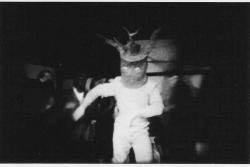
Film(Dzama)

Film(Dzama) by Deco Dawson was another high point. Regular collaborator with Guy Maddin, notably on Heart of the World and Dracula: Pages from a Virgin’s Diary (one of the best film’s I’ve seen in a long while), Dawson’s craft is impeccable. He has been winning awards and acclaim all over, including last year’s Toronto Film Festival, and it’s easy to see why. With the evocation of surrealist silent cinema’s form and aesthetic, Dawson here constructs an homage to visual artist Marcel Dzama, and the result is essentially indescribable. Pure cinema, to say the least. This purity of cinema can also be seen in Cinéma Barroco‘s final piece: Peter Tscherkassky’s Dream Work. An unbelievable exploration of celluloid’s material qualities, the film slips over itself revealing negative images, superimpositions, sprocket holes wavering in and out of the frame, and a feverish editing pace that seems to pull the viewer between the frames of the film to become enmeshed within it, just like the dreaming woman who serves as the film’s subject. In the director’s own words: “Dream Work is – after L’Arrivée and Outer Space – the third section of my CinemaScope Trilogy.
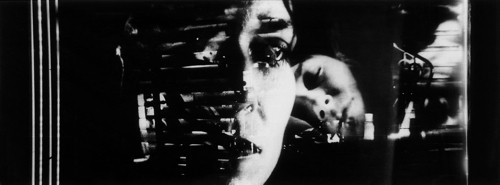
Dream Work
As Rhys Graham suggests: “Tscherkassky’s films are confounding because on the one hand, they can be explosively violent ruptures of the usual artifice of cinema, and on the other, they are sensually overwhelming, seductive experiences to which it is very pleasurable (and often physically staggering) to surrender.” 4 . This duality of distanciation and seduction is the “between space” of recognizing the familiar while realizing how strange it has become through its displacement. This is the middle ground at the heart of sample-based art which, at base, originated with the mind’s processes of sorting out memory long before reproduction technology made the act more concrete in the hands of artists.
The short programme entitled "Archaeology of Everyday Life" was also dedicated to the concept of recontextualization. Christoph Girardet’s Scratch was a notable entry here, consisting entirely of looped shots of turntables spinning their discs with the accompanying sounds of vinyl pops and scratches. What is especially interesting here is that the loops are formed so that the revolutions of the records themselves are seamless. Thus, evidence of the looping action has to be sought elsewhere, often in the corners of the frame where some slight movement of a curtain blowing in the breeze reveals its discontinuity on the edit point. Here, like in the works of Tscherkassky, a dichotomy is set up between opposing forces – the flow of the seamless revolution and the discontinuity of other elements in the frame – which rely on the same principle of the loop for their existence. So flow is not incongruous with rupture, just as distance and involvement are not incongruous in Dream Work.
Flow and ruptures in line are two of the main formal characteristics of hip-hop art (DJ music, graffiti and breakdancing) identified by Tricia Rose in her book Black Noise. 5 It is indeed interesting to consider these elements in light of the possibility of their simultaneous co-existence. Flow and ruptures in line are epitomized by what is known in DJ parlance as the “breakbeat,” the extension of an isolated portion of a record through its repetition. This repetition, however, is facilitated by the act of backspinning the record to the start point of the selected segment, which necessarily results in the temporary rupture of the segment’s flow. Girardet’s film, then, might best be understood as a distillation of the breakbeat concept, involving an infinite repetition of a small segment of a record marked by the ruptures this repetition makes manifest.
Though distilled in Scratch, Girardet’s interests in sample construction have been more blatant elsewhere. The filmmaker’s own words about an earlier piece help to shed light on the more subtle aspects of Scratch:
“The video Enlighten collages found images of scenes of lightning taken from a variety of existing films. The images are not ‘film from the real,’ but were artificially produced for those films. They are clichés that suggest drama, fate, or divine forces. Separated from their narrative context, they become signs, filled with emotion. The arrangement of the material as very short sequences corresponds to a physical perception of the lightning phenomena. Due to the alternating light/darkness, associated with ‘electricity,’ the monitor where the work is presented recalls a machine that permanently seems to be switching ‘on’ and ‘off.’ Rhythmic montage, the increasing speed between constantly shorter sequences and breaks, as well as the synchronically cut sound montage, heightens the original intensity of the images, which is transformed into a suggestive interplay between light and dark, presence and absence, recognition and illusion” 6 .
This idea of the interplay between opposing forces made possible by isolation and recontextualization of samples is central to Scratch as well, as I have suggested.
Investigation of sample recontextualization was taken to extreme lengths in the final film of the "Archaeology of Everyday Life" programme, an hour long video-essay on the collection of found objects by Alain-Paul Mallard. His film, Évidences – Cet obscure désir de l’objet, chronicles one man’s obsession with the gathering and categorization of random things found on the ground.
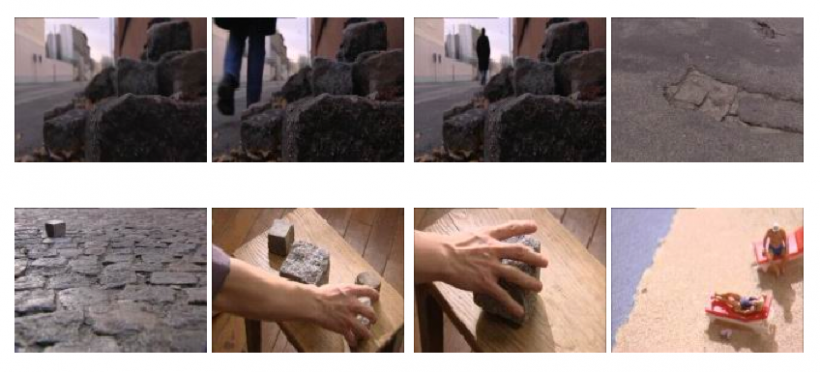
His basic premise, stated in the film, is that as children we all lived much closer to the ground. When we grow up, the ground has much less importance. He wants to get back to the wonder of a child, living close to the ground and finding all kinds of things that adults would never notice. The individual objects, he says, are fragments that tell us something about the world as a whole. Each object is a microcosmic sign of the larger picture. Fractal geometry comes to mind here, as do the principles of holography whereby any one segment of the holograph contains the entire image; if a piece of a hologram is isolated from the context of the larger whole, it will reproduce the entire holographic image, but on a smaller scale. Collectively, his vast assortment of objects plagues him with the following questions: how do they relate to each other? What juxtapositions and interconnections can be made between them? How best should they be categorized? Herein lies the film’s essential exploration.
Ultimately, the film is a grueling bore, but only in its execution. I am constantly struggling with issues of categorization, cross-referencing, etc., and in the film the man converses with several people about how to deal with his collection of found objects. They try organizing by colour, but then decide this is too conformist. They try classification by shape, but run into similar philosophical misgivings. They try playing games, creating little equations out of the objects: object A + object B = object C (with some hilarious and ingenious results). He then creates amalgamations of various objects into new forms and photographs them in varying contexts for display in still other varying contexts.
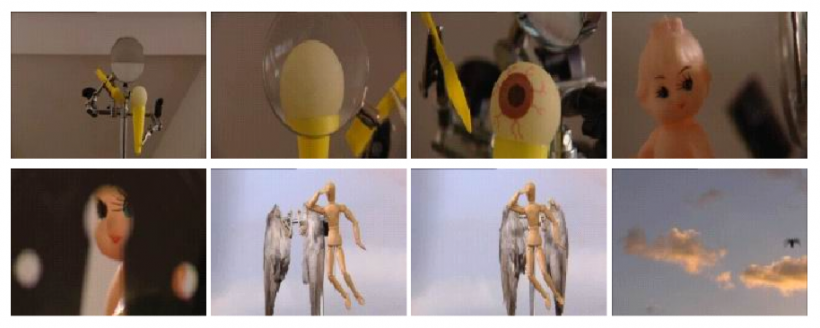
Essentially, his collection is constantly changing in terms of the relationships of the individual objects to each other and to the group as a whole. His collection is a living entity ever in search of some kind of order, and as such can be understood as an indication for the man’s own quest for order in the world. The film ends by asking “c’est quoi un classification parfait?” The final image is an arrangement of all the objects in a large design, exceeding any rational classification and taking on an organic structure all its own.
The question concerning what a perfect classification system would entail seems to be finding new relevance in the world of hypertext. Indeed, the works of Michael Snow have prompted many critics to try and find a way to organize the lot into neat categories. Following Mallard’s line of questioning, however, the works would always be subject to re-evaluation with respect to one another and to the world as a whole. So it would seem that the Digital Snow DVD-Rom is an example of how to solve the quandaries of classification: the works are all represented, but how they are organized is up to the whims of the user. This is the future of archival systems, and perhaps of rational thought as well. No longer do we need to be subjugated by hierarchical strategies of reasoning where one thing leads clearly to the next. Our minds never really worked this way in the first place – we have just forced ourselves into this way of being through the adoption of language. But there are other languages – those of cinema and music, for instance – which can offer ways of recapturing the rhizomatic interconnections that our minds are based upon and bring these back into the world outside ourselves. Deleuze himself suggests that cinema has the potential to restructure thought because of its ability to show us representations of “virtual memory,” memory that exists along side the present and is just as real and capable of affecting that present as anything happening in the moment. 7 The hypertext environment is one of the clearest evolutions of cinema’s potential in this regard, and so the Digital Snow DVD-Rom seems like a paradigm for the possibilities of future art thought and art practice alike – if only the damn thing worked! Maybe the current state of technological imperfection is why Mallard is still picking things up off the street to satisfy his quest for the ultimate classification system.
Of course, technological imperfection is what inspires many artists to use said technology for expressive purposes in the first place. Just such inspiration was demonstrated by Concordia resident film production instructor Jean-Claude Bustros in his piece Rivière O. Housed in the programme titled, simply: "Experimental Cinema," Bustros’ film delves deep into the pixilated netherworlds of MPEG audio/video encoding. The state of streaming audio and video on the net is still in its infancy, which makes it ripe for artistic exploration. Musique Concrète practitioners harnessed the potential of the radio and tape recorder to yield sound not intended by their designers; hip-hop DJs latched onto the vinyl scratch as the signature of a new generation of technological manipulators; glitch-hop producers brought a similar mentality to the sounds of CDs skipping and other digital artifacts; and now the time is right to exploit the very strange and wonderful by-products of MPEG. The little munchkin burps and hiccups that plague our mp3s, the decidedly non-analog image disjunctions found on DVDs, and the glorified slide-shows that we call online video-streaming, are all elements that cry out for appropriation.
And appropriately, Bustros does. Rivière O is based on a few scenes from Marlon Brando’s One Eyed Jacks passed through a particularly problematic MPEG stream. The giant square pixels are as large as heads in some spots, the semblance of motion reduced to a kind of stasis infused with the occasional jerk, and the present frame is populated by individual pixels from upcoming and preceding frames poking through the latticework (and announcing very clearly the redundancy elimination inherent in the compression algorithm). Compressed video is not about the progression of 29.7 frames per second being perceived as continuous motion; it is about storing only the non-repeating elements of each of those frames and then reconstructing them by using the redundant pieces from each other to complete the whole picture in order to give us the illusion of 29.7 frames per second. With bad compression this strategy breaks down, and whole frames give way to mosaics pieced together from the bits and pieces that the MPEG encoder saw fit to keep on hand. Rivière O spends 14 minutes on these audiovisual oddities that might ordinarily be nothing more than a passing glitch. It is as though the media player is stuck, and the image struggles in its semi-composed form to find its way along the linear path which is not inherent to its nature. This gives us the time to soak up the nuances and textures of this peculiar form of visual distortion, with little bits of dialogue surfacing eerily through the heavily worked soundscape Bustros created to augment the sense of the otherworldly in the piece. The film is more than just a reworking of Duchamp’s Fountain whereby we are asked to consider as art a vulgar part of daily existence simply because it is thrown up on a screen. It is a celebration of worlds as yet unexplored, worlds created by the technology born of our own imperfect hands. I believe we can learn much about ourselves by studying the extensions that we build from ourselves, and exploration of technological imperfection is a key element in such an education.
The film I most eagerly awaited this year was Joost Rekveld’s #23.2 – Book of Mirrors which played in the same programme as Rivière O. I was introduced to the filmmaker’s work in the Mutek_Vision film series last June which featured his stunning #11 (Marey <-> Moiré). Having seen #11 three times now, I can honestly say that it is one of the best cinematic experiences I have had. Needless to say, this fact built up an unhealthy store of expectations for #23.2 which were not met. However, the lack was not because of any inferiority in the filmmaking. In fact, the two are scarcely comparable. I simply was not expecting something as different as this. Clearly I need to get a broader view of Rekveld’s work, which I will endeavor to do at every occasion possible.
From what I have read about his working methods and philosophies, Rekveld is an intensely focused craftsman dedicated to exploring the very essence of cinema. His main purpose in filmmaking is to investigate the pure properties of light moving in time, the combination of elements that Willaim C. Wees suggests makes cinema unique (though I would have to take some issue with his neglect for sound in that equation…) 8 . To provide a sense of his work and his methods, Rekveld explains the #23 series:
23 will grow to be a cycle of five abstract films about light, inspired by concepts found in medieval and renaissance optics. The films are made with a set-up in which I use ancient and very elementary optical principles to generate images. These images are caused by the interplay of light waves directly onto the emulsion, not using lenses as they are used normally to reproduce a scene outside of the camera. In that way I try to explore alternative forms of spatiality not related to traditional pictorial perspective. #23.2 Book of Mirrors deals with the multiplication of light beams through mirrors and kaleidoscopes. The structure of the film has been developed in close cooperation with composer Rozalie Hirs who wrote the music for it. The composition is based on symmetries and inversions of proportions and gestures throughout the film. 9
In fact, the music was one of the things that threw me off at first, since it was an orchestral piece with choral elements that stood in stark opposition to the mechanical/electronic sounds produced by Edwin van der Heide for #11. Maybe Peter Mathews is right about the impetuousness of youth – it is indeed the intensity of the spectacle in #11 that blows me away, an intensity that is not present in #23. Of course, I’m glad to see Rekveld isn’t a one-trick pony. In retrospect #23 is a very beautiful piece, understated and elegant in its formal abstraction, and I would love the opportunity to give it another sitting so I can evaluate it without the pretense and particularities of expectation (though perhaps I should allow myself to turn 30 first). However, the chance for a second viewing will likely never come, a fact that lends some credibility to my suggestion that the strength of FCMM lies in its short programmes – a place where we can be exposed to areas of the cinematic arts that rarely find space on the public screen.
Now don’t get me wrong: there were several outstanding feature films at FCMM 2002. Of note were Peter Mettler’s Gambling, Gods, and LSD, Guy Maddin’s Dracula: Pages from a Virgin’s Diary, and Alexander Sokurov’s Russian Ark – a film so far out of the class of any others in the festival this year that it really deserves to be seen and discussed completely on its own terms. But the Mettler film has already enjoyed a post-festival release, Russian Ark opens at the end of this month, and Maddin’s Dracula will surely find a home once the prints are finished making the festival circuit. So, I will state again that it is the more fleeting pleasures that I appreciate in the festival environment and which I feel allow for an atmosphere of variety and experimentation. There is nothing more fleeting than live performance, and the FCMM organizers have seen fit to remove this element from the festival. So, with that gone, it is up to FCMM’s excellent short film programmers to continue providing us with access, brief as it may be, to a rich world of cinematic exploration that will not readily be seen again once the festival is said and done.
Notes
- Peter Tscherkassky. Dream Work ↩
- Jameson, Frederic. Postmodernism, or, The cultural logic of late capitalism. Durham: Duke University Press, 1991. ↩
- Deleuze, Gilles + Felix Guattari. A Thousand Plateaus. Brain Massumi, trans. Minneapolis: University of Minnesota Press, 1987. ↩
- Rhys Graham. "Outerspace: The Manufactured Film Of Peter Tscherkassky." ↩
- Rose, Tricia. Black Noise: Rap Music and Black Culture in Contemporary America. Hanover: Wesleyan University Press, 1994: 38. ↩
- Girardet, Christoph. “Some New Minds.” ↩
- Colebrook, Claire. Gilles Deleuze. London: Routledge, 2002:33. ↩
- Wees, William C. Light Moving in Time: Studies in the Visual Aesthetics of Avant-Garde Film. Berkeley: University of California Press, 1992. ↩
- Rekveld, Joost. #23.2 -Book of Mirrors ↩

